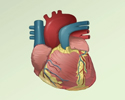Understanding cardiovascular disease
Cardiovascular disease is the broad term for problems with the heart and blood vessels. These problems are often due to atherosclerosis. This condition occurs when fat and cholesterol build up in blood vessel (artery) walls. This buildup is called plaque. Over time, plaque can narrow blood vessels and cause problems throughout the body. If an artery becomes blocked, it can lead to heart attack or stroke.
Atherosclerosis
Atherosclerosis, sometimes called "hardening of the arteries," occurs when fat, cholesterol, and other substances build up in the walls of arteries. ...

Cholesterol
Your body needs cholesterol to work properly. When you have too much cholesterol in your blood, it builds up inside the walls of your arteries (bloo...

Types of Cardiovascular Disease
Coronary heart disease (CHD) is the most common type of heart disease when plaque builds up in the arteries leading to the heart. CHD is also called coronary artery disease (CAD). When arteries narrow, the heart cannot get enough blood and oxygen. A blocked artery can cause a heart attack. Over time, CHD can weaken the heart muscle and cause heart failure or arrhythmias.
Coronary heart disease (CHD)
Coronary heart disease is a narrowing of the blood vessels that supply blood and oxygen to the heart. Coronary heart disease (CHD) is also called co...

Heart attack
Most heart attacks are caused by a blood clot that blocks one of the coronary arteries. The coronary arteries bring blood and oxygen to the heart. ...

Heart failure occurs when the heart muscle becomes stiff or weak. It cannot pump out enough oxygen-rich blood, which causes symptoms throughout the body. The condition may affect only the right side or only the left side of the heart. More often, both sides of the heart are involved. High blood pressure and CAD are common causes of heart failure.
Heart failure
Heart failure is a condition in which the heart is no longer able to pump oxygen-rich blood to the rest of the body efficiently. This causes symptom...

Arrhythmias are problems with heart rate (pulse) or heart rhythm. This happens when the heart's electrical system doesn't work properly. The heart may beat too fast, too slow, or unevenly. Certain heart problems, such as heart attack or heart failure can cause problems with the heart's electrical system. Some people are born with an arrhythmia.
Arrhythmias
An arrhythmia is a disorder of the heart rate (pulse) or heart rhythm. The heart can beat too fast (tachycardia), too slow (bradycardia), or irregul...

Heart valve diseases occur when one or more of the four valves in the heart do not work properly. Blood can leak through the valve in the wrong direction (called regurgitation), or a valve may not open far enough and block blood flow (called stenosis). An unusual heart sound, called a heart murmur, is the most common symptom. Certain heart problems, such as heart attack, heart disease, or infection, can cause heart valve diseases. Some people are born with heart valve problems.
Heart murmur
A heart murmur is a blowing, whooshing, or rasping sound heard during a heartbeat. The sound is caused by turbulent (rough) blood flow through the h...

Peripheral artery disease occurs when the arteries to your legs and feet become narrow due to a buildup of plaque. Narrow arteries reduce or block blood flow. When blood and oxygen can't get to the legs, it can injure muscles, nerves, and other tissue.
Peripheral artery disease
Peripheral artery disease (PAD) is a condition of the blood vessels that supply the legs and feet. It occurs due to narrowing of the arteries in the...

High blood pressure (hypertension) is a cardiovascular disease that can lead to other problems, such as heart attack, heart failure, stroke, and kidney disease.
High blood pressure (hypertension)
Blood pressure is a measurement of the force exerted against the walls of your arteries as your heart pumps blood to your body. Hypertension is the ...

Stroke is caused by a lack of blood flow to the brain. This can happen because of a blood clot traveling to the blood vessels in the brain, or bleeding in the brain. Stoke has many of the same risk factors as heart disease.
Stroke
A stroke occurs when blood flow to a part of the brain stops. A stroke is sometimes called a "brain attack. " If blood flow is cut off for longer th...

Congenital heart disease is a problem with the heart's structure and function that is present at birth. Congenital heart disease can describe a number of different problems affecting the heart. It is the most common type of birth defect.
Congenital heart disease
Congenital heart disease (CHD) is a problem with the heart's structure and function that is present at birth.

Reviewed By
Thomas S. Metkus, MD, Assistant Professor of Medicine and Surgery, Johns Hopkins University School of Medicine, Baltimore, MD. Also reviewed by David C. Dugdale, MD, Medical Director, Brenda Conaway, Editorial Director, and the A.D.A.M. Editorial team.
Goldman L. Approach to the patient with possible cardiovascular disease. In: Goldman L, Cooney KA, eds. Goldman-Cecil Medicine. 27th ed. Philadelphia, PA: Elsevier; 2024:chap 39.
Newby DE, Grubb NR. Cardiology. In: Penman ID, Ralston SH, Strachan MWJ, Hobson RP, eds. Davidson's Principles and Practice of Medicine. 24th ed. Philadelphia, PA: Elsevier; 2023:chap 16.
Disclaimer




 All rights reserved.
All rights reserved.